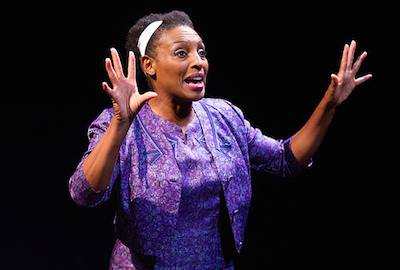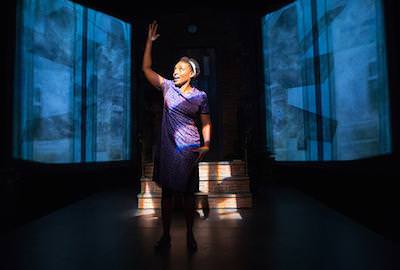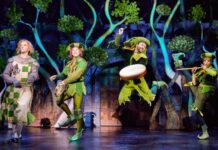Theater J has just extended the run of Caleen Sinnette Jennings’ semi-autobiographical Queens Girl in the World through October 18, and my viewing of the play last night left no doubt in my mind about why. As writing for the stage, it is a transcendent theatrical treasure. As solo performance, it is (to borrow the 60s slang of its main character) beyond boss.
Queens Girl in the World is also a breathtaking dramatization of the meaning of race consciousness in America.
In one of the play’s profusion of poignant moments, the titular Queens girl, Jacqueline Marie Butler, learns of the 1963 bombing in a Baptist church in Birmingham that left four girls dead. As she recites the names of the murdered girls, black-and-white photos of their faces appear on the back wall of the set. The girls are about her own age, Jackie reflects. One of them resembles a girlfriend.

At this point in the play, Jackie is attending the Irwin School in Greenwich Village, almost all of whose students are white. She shuttles back and forth daily on the subway between Greenwich Village and her parents’ home on Erickson Street in a black neighborhood in Queens. Jackie knows that all the white former homeowners have fled—an exodus prompted by her father’s purchase of their house. Jackie also knows that there is a divide between her world at home and her world at school, a split that requires the presentation of her very self to switch. She is, she says, “afraid of being the wrong me in the wrong place.” So she turns to writing, because “it helps me make peace between the Erickson Street Jackie and the Irwin School Jackie.”
Suddenly in the white world of her school days, the Birmingham bombing changes everything. Jackie realizes the adults and students around her now perceive her blackness differently. Though they do not do so meanly—a counselor checks in on her solicitously—the experience stings. “Why does it take blowing up a church for them to see me?” Jackie asks.
The event not only changes the meaning of her race in the eyes of others; the experience becomes central to Jackie’s consciousness of the meaning of her race to herself. “Where will I find my place in the world?” she asks, now aware that the world is more precarious and treacherous than she imagined. And in an eloquent scene accompanied by words projected on the set, Jackie reads to her classmates a poem she wrote affirming and owning her blackness.
Presumably this pivotal scene was in Jennings’s script before the mass shooting in June at a Methodist Episcopal church in Charleston that left nine people dead. For a short while, white pundits’ conscience was pricked. (Somehow news cycles function like mental rinse cycles when it comes to white Americans’ understanding of whatever #BlackLivesMatter might be about.) Still the echo of 2015 Charleston in Jennings’s reference to 1963 Birmingham felt like a sonic boom.
Queens Girl in the World begins as something of a light comedy, and last night swells of laughter in the audience rolled like precision-paced waves (Eleanor Holdridge’s direction is masterful). The play is essentially a young girl’s coming-of-age story—we see her coping hilariously with parental overprotectiveness, girlfriend dramas, boyfriend crushes, and the like. Dawn Ursula, who gives a virtuoso performance as the endearing Jackie (while also channeling an entire cast of other characters), utterly charms the audience. And in a subtle way, the play is crafted to invite the audience into a viewpoint that—not unlike Jackie’s—is not race-conscious at all. To be sure, the details of Jackie’s world—especially its popular music—reference black-infused culture. But Jackie herself attaches no particular political significance to being, and being seen as, black. And in a wonderfully winning way, the play allows or invites the audience also to see past the protagonist’s race.

Even Jackie’s anguished report of an incident involving a neighbor, Grampa Wilson—as chilling as it is—serves to keep the audience lulled into a consciousness of a character who could be Anytween. See that? Jackie was just treated like a girl in a male world. We have not actually seen her treated as a black girl in a white world as well.
What happens in Queens Girl in the World is that Jackie, who grew up not knowing a whole lot about race hate, learns about it and then some. (There is a stunning and stirring passage in Act Two when a “freckle-faced man with kind eyes”—Malcolm X—comes to visit her family’s home.) At the same time what Jennings’s play makes happenfor an audience is an opportunity—through identification with a lovable lead character—to join Jackie’s journey to race consciousness right alongside her.
I can’t guess for how many white audience members that effect occurred last night. Maybe many, maybe a few. But what I do know for certain is that Queens Girl in the World opened its arms to that possibility—and embraced us all in the pure passion of its extraordinary vision of a place for Jackie in the whole wide world.
Running Time: One hour and 50 minutes, including one 15-minute intermission.
Queens Girl in the World plays through October 18, 2015 at Theater J at The Washington DCJCC’s Aaron & Cecile Goldman Theater – 1529 16th Street, NW, (16th and Q Streets), in Washington, DC. For tickets, call the box office at (800) 494-8497, or purchase them online.





